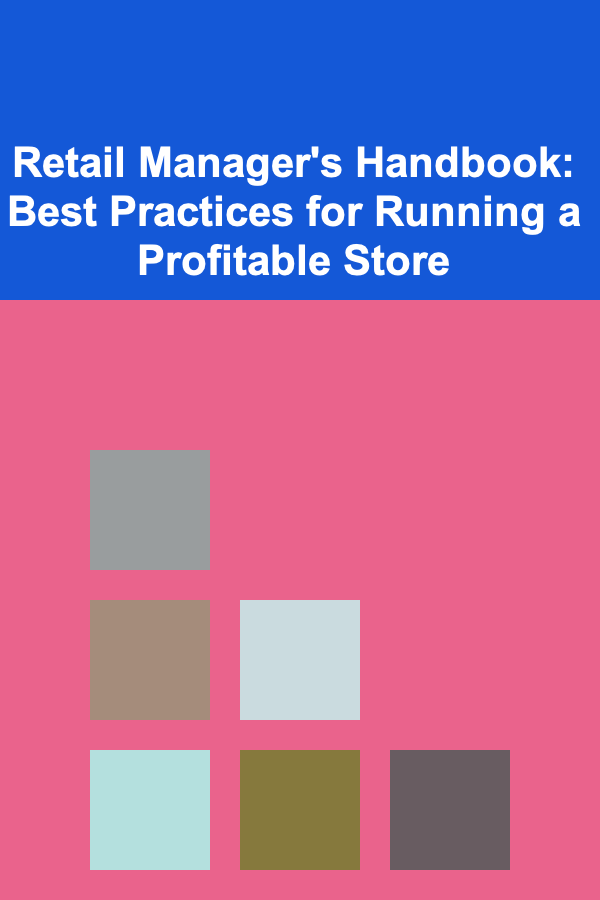
Retail Manager's Handbook: Best Practices for Running a Profitable Store
ebook include PDF & Audio bundle (Micro Guide)
$12.99$7.99
Limited Time Offer! Order within the next:

Running a profitable retail store is not just about selling products. It's about creating a seamless, customer-centric experience, managing operations effectively, and making data-driven decisions to optimize every aspect of your business. Whether you're overseeing a small boutique or managing a large chain, the principles of profitability remain the same. In this guide, we will explore the best practices for retail managers to not only boost sales but ensure long-term success in a competitive market.
Mastering Inventory Management
1.1 Keep Stock Levels Optimal
Effective inventory management is essential to maintaining profitability. Too much inventory ties up cash flow, while too little stock can lead to missed sales opportunities. The key is to strike a balance between meeting customer demand and avoiding overstocking.
- Leverage Inventory Management Systems (IMS): Invest in a robust IMS to track stock levels, monitor sales trends, and automate the reordering process. These systems allow you to keep an eye on slow-moving and fast-moving items, helping you forecast demand accurately.
- Use Just-in-Time (JIT) Inventory: The JIT system ensures that products arrive just when you need them, minimizing excess stock and reducing storage costs. This system works best when paired with a strong relationship with suppliers who can deliver quickly.
- Regular Audits: Conduct periodic stock audits to reconcile physical stock with digital records. This can help prevent stock discrepancies and identify potential issues like theft or supplier errors.
1.2 Analyze Sales Data
Your inventory decisions should be driven by data. Analyzing historical sales data helps to identify seasonal trends, product performance, and customer preferences.
- Sales Forecasting: Use past sales data to predict future demand. For example, if a product sold well during last year's holiday season, you can forecast a similar demand and stock accordingly.
- Stock Turnover Rate: Calculate how often your inventory is sold and replaced over a certain period. A high turnover rate indicates strong sales and efficient inventory management, while a low rate suggests overstocking or poor product performance.
1.3 Manage Shrinkage
Shrinkage, which includes loss of inventory due to theft, damage, or administrative errors, is a major drain on profitability. Implementing strong loss prevention measures is critical for minimizing shrinkage.
- Security Measures: Invest in security cameras, electronic article surveillance (EAS) systems, and well-trained security staff. Regularly monitor these systems to identify potential threats.
- Employee Training: Train employees to recognize suspicious behavior and follow proper checkout procedures. Ensuring that employees are aware of shrinkage risks can help reduce internal theft.
- Stockroom Organization: Keep the stockroom organized and well-monitored. An accessible and organized stockroom reduces the risk of theft and inventory errors.
Efficient Labor Management
2.1 Scheduling for Peak Performance
Labor costs often account for a large portion of a store's operating expenses. Efficient labor management involves ensuring that the right number of employees are on the floor at the right times.
- Use Historical Data to Forecast Needs: Look at past sales data and customer foot traffic patterns to predict when the store will be busiest. For example, if your store sees a significant uptick in sales on weekends or during certain holidays, ensure you have sufficient staff scheduled during those times.
- Cross-Train Employees: Cross-training employees to handle multiple roles (e.g., sales, stock management, customer service) helps ensure flexibility when demand changes unexpectedly.
- Employee Motivation and Retention: High turnover can increase labor costs due to recruitment and training expenses. By providing competitive pay, offering career development opportunities, and fostering a positive work culture, you can retain top-performing employees and reduce turnover.
2.2 Monitor Labor Costs
Balancing labor costs with sales is essential to profitability. Too much labor can eat into profits, while too little can negatively impact customer service.
- Labor-to-Sales Ratio: Monitor your labor costs as a percentage of sales. A common benchmark is that labor costs should be between 10-20% of total sales, but this can vary by industry and store type.
- Overtime Management: Keep track of employees' overtime hours. While overtime can sometimes be necessary, excessive overtime can lead to higher costs and employee burnout. Use scheduling software to track hours and minimize overtime.
Optimizing Sales Strategies
3.1 Upselling and Cross-Selling Techniques
Maximizing the average transaction value is key to increasing revenue. Effective upselling and cross-selling can significantly boost sales without requiring additional customers.
- Upselling: Encourage customers to purchase higher-end versions of products. For example, if a customer is purchasing a smartphone, suggest a higher model that has better features.
- Cross-Selling: Recommend complementary products that enhance the primary item the customer is purchasing. For instance, if a customer buys a pair of shoes, suggest a matching handbag or shoe care product.
- Training Your Team: Teach your sales team how to approach upselling and cross-selling naturally, ensuring they focus on customer needs rather than aggressively pushing additional products.
3.2 Pricing Strategy
Pricing can significantly affect your store's profitability. A well-structured pricing strategy ensures you stay competitive while maintaining healthy margins.
- Competitive Pricing Analysis: Regularly check competitor prices to ensure you're not overpriced or underpriced. Price too high, and you risk losing customers; price too low, and you may undermine your profit margins.
- Psychological Pricing: Use psychological pricing techniques like pricing products at $9.99 instead of $10. This small difference can psychologically feel like a better deal to customers, driving increased sales.
- Tiered Pricing: Offer tiered pricing for similar products, encouraging customers to choose higher-end products by showcasing the added value they offer.
3.3 Seasonal Promotions and Discounts
Strategic promotions and discounts can drive traffic and increase sales, but they must be managed carefully to avoid eroding profit margins.
- Plan Ahead: Ensure your promotions align with seasonal trends, holidays, or store events. For example, running a back-to-school promotion on school supplies or offering discounts on winter wear before the cold season sets in.
- Flash Sales and Limited-Time Offers: Create urgency with flash sales and time-limited offers. This can encourage customers to make quick purchase decisions and increase foot traffic to the store.
- Bundle Offers: Offer product bundles at a discount. Bundling products together at a lower price can increase sales of related items and move slow-moving inventory.
Creating a Positive Customer Experience
4.1 Exceptional Customer Service
Customer service is one of the most effective ways to build loyalty and boost profitability. A positive experience can turn one-time shoppers into repeat customers.
- Train Staff in Customer Interaction: Teach your employees to greet customers warmly, be knowledgeable about the products, and handle complaints or issues with professionalism. Empower them to resolve problems without always needing managerial approval.
- Personalized Service: Customers appreciate being remembered. Use customer data to offer personalized shopping experiences. If a customer frequently buys a certain brand or type of product, suggest new arrivals in the same category.
- Follow-Up and Feedback: After a purchase, encourage customers to leave feedback and offer them a chance to rate their experience. Respond to reviews---both positive and negative---to show that you value customer input.
4.2 Store Environment
The physical store environment plays a crucial role in attracting customers and encouraging them to make purchases.
- Cleanliness and Organization: Ensure the store is always clean, organized, and easy to navigate. Customers are more likely to return to a store that is neat and pleasant.
- Visual Merchandising: Use strategic product displays to highlight key products, especially new arrivals or high-margin items. Eye-catching displays draw customers' attention and encourage them to explore.
- Lighting and Ambiance: The right lighting can make a huge difference in a store's atmosphere. Bright lighting can energize customers, while softer lighting creates a more relaxed shopping environment. Pay attention to how lighting and music can influence the shopping experience.
Financial Management and Profitability
5.1 Understanding Profit Margins
Profit margins directly affect the overall profitability of your store. Retail managers must understand how to calculate and improve profit margins for every product.
- Gross Profit Margin (GPM): This metric tells you how much money you make after accounting for the cost of goods sold (COGS). To calculate GPM, subtract COGS from total revenue, then divide by total revenue.
- Net Profit Margin: This takes all operating expenses into account, giving you a more accurate picture of overall profitability. Monitoring both gross and net profit margins helps you identify areas for improvement.
5.2 Controlling Operating Expenses
Keep operating expenses under control by monitoring all aspects of store operations, from rent and utilities to payroll and marketing costs.
- Negotiate with Suppliers: Regularly review supplier contracts to ensure you're getting the best deal. Negotiate for better pricing or explore alternative suppliers that can offer the same quality at a lower price.
- Energy Efficiency: Reduce energy costs by investing in energy-efficient lighting, heating, and cooling systems. Small changes like switching to LED lights can have a significant impact over time.
- Optimize Marketing Spend: Focus your marketing budget on channels that generate the highest ROI. Digital marketing, such as social media and email campaigns, often offers better targeting and cost-effectiveness than traditional methods like print ads.
Conclusion
Running a profitable retail store requires a combination of strategic planning, effective operations management, and an unwavering focus on customer satisfaction. By implementing best practices in inventory management, labor optimization, sales strategies, and customer experience, retail managers can improve profitability and create a sustainable business model. In the competitive world of retail, adaptability, and constant learning are key to maintaining success and ensuring long-term growth.

How to Organize Your Fitness Equipment for Easy Access
Read More
Lowering Insurance Premiums: Top Strategies for Finding Affordable Coverage
Read More
Mastering Data Engineering: Essential Skills for the Modern Data Engineer
Read More
Mastering Arm Balances in Yoga: A Comprehensive Guide
Read More
How to Edit Photos for Print vs. Digital
Read More
10 Tips for a Sustainable Self-Care Checklist
Read MoreOther Products

How to Organize Your Fitness Equipment for Easy Access
Read More
Lowering Insurance Premiums: Top Strategies for Finding Affordable Coverage
Read More
Mastering Data Engineering: Essential Skills for the Modern Data Engineer
Read More
Mastering Arm Balances in Yoga: A Comprehensive Guide
Read More
How to Edit Photos for Print vs. Digital
Read More